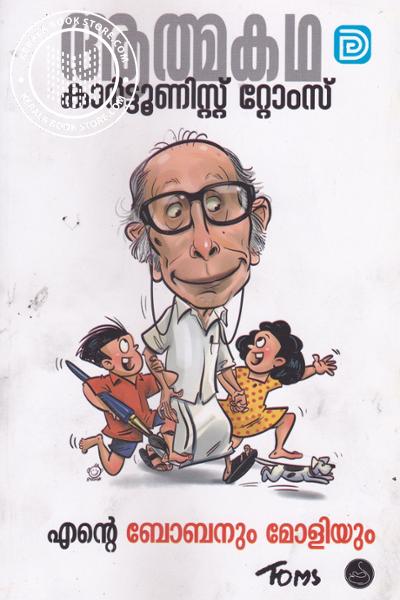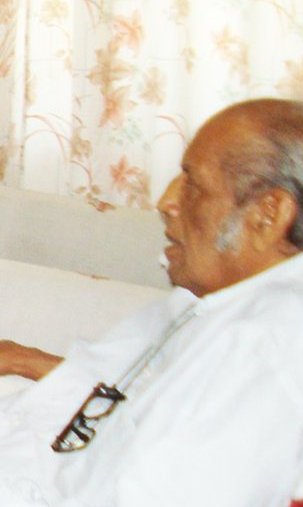
In the early eighties a literary camp for students held at my school St. Joseph’s HS, Thiruvananthapuram was graced by the visit of a tall, balding guest of dark complexion who conducted a rapid lecture demo on the fine art of drawing. With a couple of deft strokes of the chalk piece, he conjured up on the blackboard two of the most recognizable fictional faces yet in the Malayali psyche. The cartoon strip characters were 12-year-old twins Boban and Molly and the magician weaving them was V. T. Thomas better known as Toms. The Kuttanad born Toms was working out of Kottayam then, serving the grand old lady of the town, Malayala Manorama; the group’s weekly Malayalam rag mag to be precise. Manorama weekly was synonymous with the cartoon strip which appeared on its last page. So popular it was that most readers read the last page first, Arabic fashion, as Mammootty pointed out while launching the memoirs of its legendary author recently. That book, ‘Ente Bobanum Molliyum’ is the subject of this review. The 380 pages long book is published by Don Books and distributed by National Book Stall.
In a TV interview still in the 80s, the then rising movie star Jayaram boasted that his entire reading was confined to just Bobanum Molliyum. But what he failed to disclose was that his Kalabhavan school mimicry lifted heavily from the strip, like the episode in which a jobless graduate goes to a circus seeking work. Ramji Rao Speaking, a movie with which Siddique-Lal redefined new wave comedy in Malayalam was a tribute of sorts to the cartoon strip. As if in subtle acknowledgment of the source a character is shown reading the comic collection in the director duo’s later movie Godfather. As happened for Arthur Conan Doyle with Sherlock Holmes, Toms’s creations easily upstaged him in popularity. The cartoonist who has been entertaining us for more than half a century keeps a conspicuously low profile.
Born in Kuttanad in 1929, Toms ran away from home to join the army in his teens. He joined Manorama as a cartoonist in 1961 and served them until his retirement as Asst Editor in 1987. He continued to draw his Bobanum Moliyum cartoon for Kalakaumudi and also independently through Toms Comics afterward. Unnikkuttan, Mandoos and Kunchukurup are his other popular strips. On course of telling his interesting life story, Toms lets us into a wealth of events, mostly in Kuttanad where he grew up, and not all of them involving him. In a way, it is a chronicle of the times, an account from the bottom of the heart of the people of the rice country, through the eyes of a wide-eyed man with a fine art sensibility. The best part of the book is the cartoon illustrations by Toms that go with the narrative. So we have sketches on every other page, making the reading a joyously visual experience as well. Most readers would be interested to know about the genesis of Toms’s characters. Boban and Molly were two naughty kids in the neighborhood whose antics intrigued him no end. But they were lovable alright. Later when Toms married and raised a family he even lent the same names to two of his six children. Daughter Molly’s son is the inspiration for Unnikkuttan who could give Dennis the Menace a run for his money. The bumbling idiot Ittunnan was inspired by a certain Unnittan, Appi hippy by a guitar-strumming artist who came for a programme in their locality, the politician was a portmanteau of many leaders from real life, and an advocate friend named Alex provided the source for the children’s father Pothen, portrayed as an idling advocate in the strip. However several characters like Motta, Aashan and Parekkuty are figments of the imagination.
I have found the Bobanum Molliyum of the first two decades more hilarious than the later period because those stories centered on the adventures of the children mostly and not so much social commentary. But the satire was biting when it came. Toms was clear from the start about the philosophy of his cartooning. A cartoon ceases to have any meaning for him it is not highlighting something negative. The book is brought to life in numerous snippets that make enjoyable standalone reads. My personal favorite is a story about a church bell-ringer who did not know how to sign and how this very handicap paved the way for eventually catapulting him to the pinnacle of success in life (page 203). The humor reaches a crescendo when narrating anecdotes of famously witty people like Rev. Chrysostom. Even though Toms’s pokes were taken in spirit by most leaders at the receiving end of them, a few like AKG took him to court. An impasse over the publishing rights of his cartoons collected in book form saw him leave Manorama, his home away from home for nearly three decades and set up a nest at Kalakaumudi. The case is dwelt upon, with a perspective that distance in time has given Toms. The book ends with an appendix note by Sebastian Paul who advocated him in the copyright case.
Toms largely led a disciplined life and that explains his longevity in terms of work. Like R. K. Laxman at the Times of India, he had his employers eating out of his hands with the unmistakable brand value of his creation. But unlike the former whom the government honored with a Padma Vibhushan, Toms has hardly won the official recognition he richly deserves. His medium being Malayalam with its limited readership is probably a constraint. A Bobanum Molliyum movie was made as far back as in 1971 by Sasikumar but it bombed. These days one can savor animated CDs of the children’s pranks apart from wading into the collected comic editions. At 86 Toms can look back at a formidable legacy, one that made the average Malayali laugh aloud and reflect long, week after week for several years without a break.

(2016)
PS: Toms passed away in 2016, aged 86